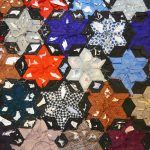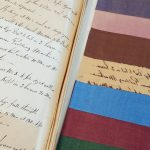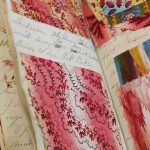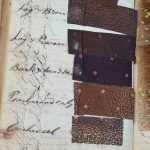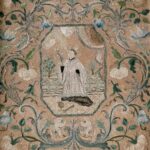This unfinished patchwork is made using the English paper piecing technique. Diamond shaped papers have been covered with fabric and arranged into a pattern of colourful stars formed by six diamonds within a framework of darker diamonds. The covered paper shapes are joined together by overcast or whip stitching. The design effectively uses high contrast […]
View moreThis book comes from Rosebank Mill in Lancashire and dates from 1832. The inside cover features the name Bennet Greig and the name of the mill and the date 25th September 1832. It contains an array of printed dress and furnishing fabrics along with detailed notes about their production. Within the pages are examples of […]
View moreThis book contains mostly printed cotton dress fabrics with a few examples of larger scale prints labelled as ‘furnitures’, which would have been used as household furnishings such as upholstery or curtains. Many of the fabric samples showcase the adoption of innovative new developments in printing technology from the early 19th century. One of the […]
View moreThis book comes from Rosebank Mill in Lancashire and contains samples of mainly dress fabrics. Most of the samples are printed on smooth, evenweave cotton although there is one sample of cotton with a ribbed pile like corduroy. The cover bears the name Thomas Comstive and indicates that the book covers the period “1832 and […]
View moreA selection of jacquard designs and fabric samples produced by Birtwistle &Oddie Ltd of Prospect Mill, Wharf Street, Blackburn. The company was founded at Prospect Mill in 1907 by H. H. Birtwistle and A. M. Oddie. The company remained there until 1972 and was known for producing jacquard woven brocades, and later cotton and rayon […]
View moreA framed colifichet embroidery depicting St Aloysius de Gonzaga worked in fine silk floss on a ground of parchment. Colifichet embroideries are a rare type of double-sided embroidery that are stitched meticulously so that each side appears the same. As shown in this example, they were usually specially framed so that both sides of the […]
View more